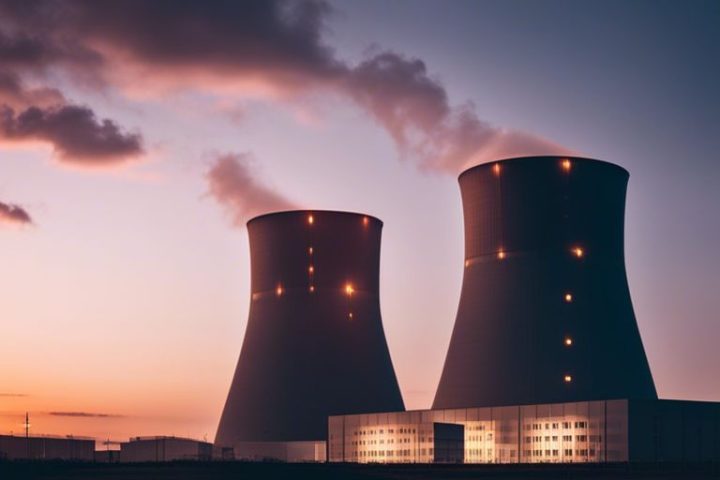Your Energy needs are increasing as populations grow and economies expand globally. Nuclear power plays a crucial role in meeting these demands by providing a reliable, low-carbon source of electricity. While there are concerns about safety and nuclear waste management, advancements in technology have made nuclear reactors safer and more efficient. Understanding the role of nuclear power in the global energy landscape is crucial for shaping the future of sustainable energy production. Let’s examine the importance and potential of nuclear power in meeting global energy needs.
The Current State of Global Energy Needs
Rising Energy Demands
Needs are constantly increasing as the global population grows, economies expand, and technology advances. This surge in needs has led to an unprecedented demand for energy. With the rise of developing countries like China and India, the energy requirements have escalated significantly. According to the International Energy Agency, global energy demand is expected to increase by 25% by 2040.
The Energy Gap: Meeting Future Requirements
Global energy demand is projected to outpace supply in the coming years, resulting in an energy gap that needs to be addressed urgently. This gap poses a significant challenge as traditional energy sources like coal, oil, and natural gas are finite and contribute to environmental degradation and climate change. You must find sustainable and reliable alternatives to bridge this gap and ensure a secure energy future for generations to come.
It is imperative to explore innovative solutions that can meet the escalating energy needs while reducing carbon emissions and minimizing environmental impact. Nuclear power emerges as a viable option in this scenario, offering a consistent and low-carbon source of energy that can help meet the growing global demands sustainably.
The Role of Nuclear Power in the Energy Mix
While the world is constantly searching for cleaner and more efficient sources of energy, nuclear power has played a significant role in the energy mix for decades. Understanding the historical context of the development of nuclear power is crucial to grasping its current position in the global energy landscape.
Historical Context: The Development of Nuclear Power
Development in the field of nuclear power began in the mid-20th century, with significant milestones such as the first nuclear reactor being built in Chicago in 1942. This marked the beginning of a new era in energy production, with nuclear power offering the promise of abundant energy with minimal greenhouse gas emissions. As research and technology advanced, nuclear power plants were constructed worldwide, providing electricity to millions of homes and businesses.
Nuclear Power Today: Capacity and Generation
Development in the field of nuclear power has led to a significant increase in both capacity and generation globally. Many countries rely on nuclear power to meet a portion of their energy needs, with over 440 nuclear reactors operating in 30 countries around the world. These reactors collectively generate a substantial amount of electricity, contributing to a more stable and diverse energy mix.
Understanding the role of nuclear power in the current energy mix is crucial for making informed decisions about the future of global energy production. While nuclear power offers zero greenhouse gas emissions and a reliable source of electricity, concerns about safety and waste management remain. By weighing the benefits and risks of nuclear power, you can better appreciate its significance in meeting the world’s energy needs.
Advantages of Nuclear Power
Zero Greenhouse Gas Emissions
If you are concerned about climate change and the environment, nuclear power offers a significant advantage with zero greenhouse gas emissions. Unlike fossil fuel-based power plants that release large amounts of carbon dioxide and other pollutants into the atmosphere, nuclear power plants generate electricity through a process that does not produce greenhouse gases.
This means that by incorporating nuclear power into the energy mix, you can significantly reduce the carbon footprint associated with electricity generation and help combat climate change in a substantial way.
Reliability and Baseload Capacity
On top of its environmental benefits, nuclear power provides reliable and consistent energy generation with baseload capacity. Unlike some renewable energy sources like solar and wind, which are dependent on weather conditions, nuclear power plants can operate continuously, providing a stable supply of electricity to meet your energy needs.
A nuclear power plant can operate at maximum capacity for extended periods, ensuring a consistent power supply regardless of the time of day or weather conditions. This reliability makes nuclear power a crucial component of a diversified energy portfolio that can effectively meet the demands of a modern society.
Energy Density and Land Use
A key advantage of nuclear power is its high energy density, which means that a small amount of nuclear fuel can produce a large amount of energy. This efficiency in energy production results in minimal land use requirements compared to other power sources, such as sprawling solar or wind farms.
Baseload power plants play a critical role in providing a continuous and reliable supply of electricity to meet the constant demand for power. Nuclear power plants excel in this area by offering a stable output over long periods, complementing intermittent renewable sources like solar and wind energy.
Challenges and Concerns
All countries face challenges and concerns when it comes to utilizing nuclear power to meet energy needs. Here are some key issues that need to be addressed:
Nuclear Waste Management
Any discussion about nuclear power must include the issue of nuclear waste management. The radioactive waste produced by nuclear power plants needs to be safely stored for thousands of years to prevent environmental contamination. Disposing of nuclear waste is a complex and costly process, and the long-term effects of storage need to be carefully considered to avoid any risks to human health and the environment.
Safety Risks and Accidents
Concerns about nuclear power often center around safety risks and the potential for accidents. While modern nuclear power plants are designed with multiple safety systems in place, accidents like the Chernobyl disaster remind us of the catastrophic consequences of a nuclear meltdown. For instance, the long-term environmental and health impacts of such accidents can be devastating and far-reaching.
High Capital Costs and Public Perception
Any discussion about nuclear power must also consider the high capital costs associated with building and maintaining nuclear power plants. Additionally, public perception plays a significant role in the future of nuclear power. Negative perceptions stemming from past accidents and concerns about safety can hinder the development of nuclear energy as a viable solution to global energy needs.
Public Perception and High Capital Costs
Costs associated with nuclear power plant construction, maintenance, and decommissioning are significant. While nuclear power is a reliable source of energy with low greenhouse gas emissions, the initial costs of building nuclear power plants are high. Public perception and concerns about safety also impact the feasibility of nuclear power as a long-term energy solution. Addressing these concerns and accurately assessing the costs associated with nuclear power are crucial steps in determining its role in meeting global energy needs.
Emerging Trends and Technologies
Next-Generation Reactors and Small Modular Reactors
Technologies surrounding nuclear power continue to evolve to meet the increasing global energy demands. Next-generation reactors and Small Modular Reactors (SMRs) are at the forefront of this evolution. These advanced reactors offer enhanced safety features, reduced waste production, and increased efficiency compared to traditional nuclear power plants.
Advanced Fuel Cycles and Recycling
Recycling of nuclear fuel plays a crucial role in maximizing the energy potential of nuclear power and reducing the amount of radioactive waste produced. Through advanced fuel cycles and recycling processes, we can extract more energy from spent fuel, reducing the environmental impact of nuclear power generation.
-
Benefits of Advanced Fuel Cycles and Recycling
1. Reduced Waste Less radioactive waste is produced through recycling. 2. Energy Maximization Extracting more energy from spent fuel contributes to efficient nuclear power generation.
International Cooperation and Knowledge Sharing
International collaboration and knowledge sharing are necessary in advancing nuclear power technologies and ensuring the safe and sustainable use of nuclear energy worldwide. By sharing expertise, resources, and best practices, countries can collectively address the challenges and opportunities associated with nuclear power.
With challenges such as climate change looming large, international cooperation in the nuclear energy sector is crucial for accelerating innovation, enhancing safety standards, and promoting the peaceful use of nuclear technology for the benefit of all nations.
Nuclear Power in the Context of Renewable Energy
After exploring the significant impact of nuclear power on global energy needs, it’s crucial to consider its role in the broader context of renewable energy sources. Nuclear power can complement renewable sources like solar and wind power, offering a reliable, steady source of energy that can fill in the gaps when these sources are not as productive.
Complementarity with Solar and Wind Power
Wind and solar power are highly dependent on environmental factors, such as wind speed and sunlight availability. During times when these sources are not generating enough power, nuclear plants can step in to provide consistent energy output. This complementarity ensures a more stable energy supply, reducing the risk of blackouts or shortages.
Grid Integration and Energy Storage
On the topic of grid integration and energy storage, nuclear power plays a crucial role. While renewables like solar and wind are intermittent, nuclear power plants provide a steady base load of electricity. This base load can be supplemented with energy storage technologies, such as batteries or pumped hydro, to balance the variations in supply from renewables.
To achieve a truly sustainable energy future, it’s crucial to consider the integration of nuclear power with renewable sources. The future lies in developing nuclear-renewable hybrid systems that combine the strengths of both types of energy generation to create a more reliable and resilient power grid.
The Future of Nuclear-Renewable Hybrid Systems
For a sustainable energy mix, nuclear-renewable hybrid systems hold great promise. By combining nuclear power with renewables, such as wind and solar, you can harness the constant, reliable output of nuclear energy while benefiting from the clean, renewable nature of wind and solar power. These hybrid systems offer a balanced solution that addresses both the need for consistent power supply and the goal of reducing carbon emissions.
Future
Future advancements in nuclear-renewable hybrid systems could revolutionize the way we think about energy generation. By integrating these two sources, we can create a more robust and sustainable energy infrastructure that meets the growing global demand while minimizing environmental impact. Embracing nuclear power alongside renewables could be the key to a cleaner, more secure energy future for all.
Final Words
So, as you reflect on the role of nuclear power in meeting global energy needs, consider the potential benefits it offers in terms of low greenhouse gas emissions and reliable energy production. While there are risks associated with nuclear power, technological advancements and safety measures continue to improve, making it a viable option for a sustainable energy future. By staying informed and engaging in conversations about nuclear power, you can contribute to shaping energy policies that prioritize environmental stewardship and energy security for generations to come.



